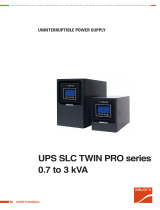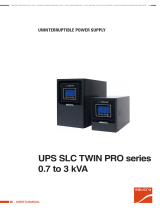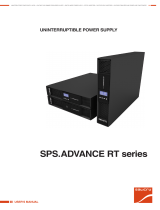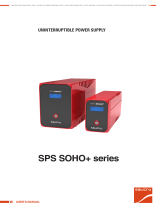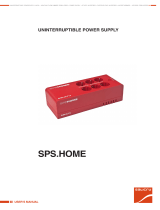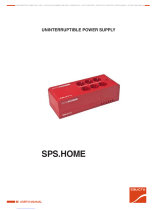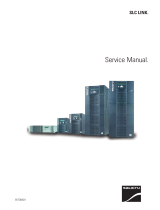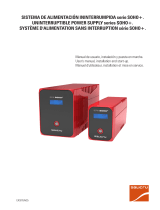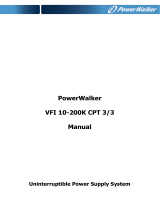
5
SALICRU
stallation or commissioning tasks, because there could be a
risk on your safety or on the other/s persons, being able to
make serious injuries even the death, also it can cause dam-
ages to the equipment and/or to the loads and installation.
• The local electrical regulations and the different re-
strictions of the client's site, they can invalidate some
recommendations included in the manuals. When discrepan-
cies exist, the user has to comply the local regulations.
• The equipments provided with power cord with plug
and outlets, can be connected and used by personnel
without any kind of experience.
The equipments with power blocks have to be installed by
qualified personnel and it can be used by personnel with
not specific training, just with only help of this manual.
A person is defined as qualified, if it has experience of as-
sembling, commissioning and perfect control operating of
the equipment, if he has the requirements to do the job and
if has read and understand all the things described in this
manual, in particular the safety indications. Such preparation
is considered only valid if it is certified by our S.T.S..
• Place the equipment the closest to the power supply and
loads to be supplied, leaving an easy access if it were needed
an urgent disconnection.
In the hardwired equipments and due to the impossibility of
fast disconnection, a disconnection device (switch) with easy
access and close to the equipment will be installed.
• Warning labels should be placed on all primary power
switches installed in places away from the equipment to alert
the electrical maintenance personnel of the presence of a
UPS in the circuit
The label will bear the following text or an equivalent one:
Before working in this circuit.
• Isolate the Uninterruptible Power System (UPS).
• Check the voltage between all terminals including the
protective earth.
Risk of voltage feedback from UPS.
1.2.3.1. General safety warnings.
• All connections and disconnections of the cables from the
equipment, including the control ones, will be done with no
power supply and the switches on rest, position «O» or «Off».
• Shutdown the equipment completely by switching «Off» the
button of the control panel first. Next disconnect the cable
from the wall outlet for standard equipments up to 3 kVA or by
switching «Off» the input circuit breaker and disconnect the
power supply cables in models 3kVA (B1) or higher power rate.
The indiscriminate manoeuvring of the switches may
involve production losses and/or equipment dam-
ages. Consult the documentation before doing any action
• Pay special attention to the labelling of the equipment
that warns about the «Electrical shock hazard». Inside
the equipment there are dangerous voltages, never open the
enclosure, the access has to be done by qualified staff. In
case of maintenance or fault, consult to the closest (S.T.S.).
• Cross cable sections used to supply the equipment and loads,
will be according to the nominal current stated in the nameplate
label of the equipment, and respecting the Low Voltage Electro-
technical Regulations or standards of the country.
Use approved cables only
• Protection Earth cable of the UPS drives the leakage cur-
rent of the load devices. An isolated earth cable has to be
installed as part of the circuit that supplies the equipment. Cross
cable section and its features will be same as the power supply
cables, but with green colour with or without the yellow strip.
All outlets of the UPS has an earth bonding, duly connected
and those equipments with power blocks there is an exclusive
terminal for the load earth connection. When an outgoing dis-
tribution is done, i.e power strips, it is essential that they have
an earth terminal connected to each one of them.
It is essential that the cables that supplies the loads have the
earth connection cable.
The protection earth must be connected to the frame
or metallic chassis of any electrical equipment (in our
case to the UPS, battery cabinet or case and loads), assuring
that it is done before connecting the input voltage.
Check the quality and availability of the earth, it has to be
between the defined parameters by the local or national
regulations.
• In small equipments (the ones connected with the foreseen
power cord with plug), the user has to check the wall outlet
corresponds with the type of supplied plug, with earth duly
installed and connected to the local protection earth.
• During the normal UPS operation, in equipments up to
3kVA the power cord cable can't be disconnected
from wall outlet, because the protection earth of the own UPS
would be disconnected and also the earth from the loads
connected to the output.
For this reason, the general protection earth cable of the
building or switchgear panel that supplies the UPS will not
be disconnected.
• In small UPS (the ones connected with the foreseen power
cord with plug), check that the sum of the leakage currents
of the UPS and connected load/s do not exceed over 3,5mA.
• The installation will have input protections sized to the cur-
rents of the equipment and stated in the nameplate label
(RCD devices type B and circuit breakers with C character-
istic or any other equivalent one).
Overload conditions are considered as a nonpermanent an
exceptional operating mode, so these currents will not be
kept in mind when sizing the protections.
• Do not overload the UPS by connecting loads with inrush
consumptions at its output, like laser printers.
• For those installations with redundant equipments or sepa-
rate Bypass line, there will only be a common RCD of 300 to
500 mA at the head of the installation for both lines.
• Output protection will be done with a circuit breaker of C char-
acteristic or an equivalent one.
It is recommended to distribute the output power, into four
lines as minimum. Each one of them will have a protection
circuit breaker sized to the quarter of the nominal power.
This kind of outgoing distributions will allow that any fault in
any device connected to the equipment, that makes a short-
circuit, will affect to the line with the faulty device only. An
uninterruptible power supply will be guaranteed to the rest of
connected loads, due to the protection tripping of the affected
line by the short-circuit only.
• When replacing a fuse, do it for another of the same type, char-
acteristics format and size.
• Under any concept the input power cord will be connected to the
output of the equipment, either directly or through other ways.
• Models with separate bypass line, a galvanic isolation
transformer has to be installed in any of the two lines
that supply the UPS (rectifier input or static bypass), to avoid
the direct union of the neutral of both lines through the in-
ternal wiring of the equipment.




















